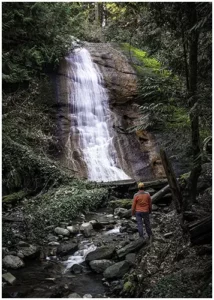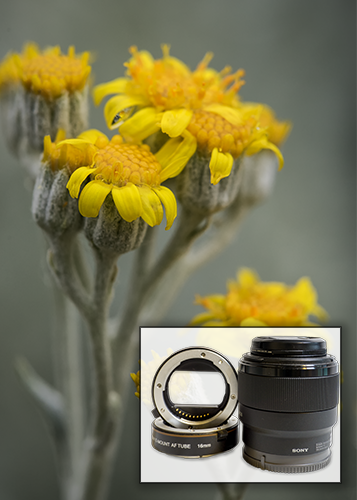
The Charming Northfield Falls in the Heart of Beach Estate Park
Looking to kill off an hour while in Nanaimo, BC? Just a short hop-skip and


Are you pondering if there is a cheaper alternative, like a lens with extension tubes, to a true dedicated macro lens? Interested in Macro Photography but not wanting to spend a lot of money upfront? Or is your camera bag full of gear and you don’t want it heavier? In this helpful guide, we will explore how you can capture close-up images using extension tubes for photography.
Throughout this guide, we will cover everything you need to know about extension tubes and their role in close-up photography. We will also delve into the mechanics of magnification and the impact of extension tubes on image quality and focus. We’ll also provide practical advice, tips for avoiding common pitfalls, and compare alternative options.
Whether you want to capture flower petals, insect details, or textures, this guide will help you understand and use extension tubes.
In this section, we will explain what extension tubes are and their role.
Extension tubes are hollow pieces that are inserted between the camera body and lens to shorten focusing limits. Consider the focal length of the lens and the camera. They allow you to achieve greater magnification and focus closer to your subject.
First you must understand what is meant by millometers of a lens. The focal length is an important factor in the optical characteristics of a camera lens. It represents the distance from the lens’s optical center to the image sensor when the lens is focused at infinity. This particular distance has profound implications for how the lens captures images.
Macro lenses magnify subjects enabling closer focusing compared to regular lenses, stretching the distance between the camera body and the lens. By increasing the distance between the lens and the camera’s image sensor, extension tubes effectively decrease the minimum focusing distance.
The market offers a variety of extension tubes, each with specific features and compatibility options. Consider the quality, compatibility, and desired magnification level when choosing extension tubes. For piece of mind look for extension tubes with electronic connections for more convenience. These tubes allow for autofocus and electronic control.
Now that you have a fundamental understanding of extension tubes and their role in micro photography, let’s explore how to use them effectively to capture stunning macro shots.
Delve into the mechanics of magnification and explore how extension tubes can enhance your close-up photography. Understanding the concept of magnification is key to capturing stunning Macro photos.
When using extension tubes, it’s important to consider their impact on image quality and focus. The increased magnification due to a 100mm macro lens may result in a narrower depth of field (DoF) in front of your lens. This implies that with a telephoto lens, only a small part of your subject will be in sharp focus in front of the lens. This is both a chance for creativity and a challenge that needs attention to detail and precise focusing techniques.
Additionally, the focusing distance and minimum focus distance of your lens will change when using macro couplers. You’ll need to adjust your approach to achieve the desired focus and ensure sharpness throughout your image.
The relationship between aperture and extension tube use is vital to understanding how to optimize image quality. Using a smaller aperture (like f/11 or f/16) with certain lens and extension tube combinations can improve DoF and image sharpness. Experimenting with different aperture settings can help you find the perfect balance between depth of field and sharpness for stunning macro photographs.
In this section, we will provide you with valuable tips and techniques for capturing perfect macro photos using focusing tubes. We understand that achieving a sharp focus and balancing the aperture are crucial aspects of close-up photography. We will focus on using focusing techniques and aperture settings to improve your macro photos with extension tubes.
When using extension tubes, it’s important to balance the aperture settings with the extension tube’s effect on depth of field. Aperture controls the amount of light entering the camera and the depth of field in your image.
To increase magnification, you can use additional tubes. However, keep in mind that this reduces the depth of field, which means that the range of tack sharp focus becomes narrower. To compensate for this, you can adjust the aperture on your camera to increase the focal range. Smaller aperture values, such as f/16 or f/22, can bring more of your subject into focus. However, keep in mind that smaller apertures can also introduce diffraction, which can impact image sharpness. Therefore, it’s essential to find the sweet spot for your lens and extension tube combination.
Focusing is a critical aspect of macro photography, especially when using tubes. Manual focus is often the preferred choice as it gives you complete control over the focus point. Autofocus may struggle at times because of the shallow depth of field.
When manually focusing with extension tubes, it’s important to be patient and precise. Here are some photography tips to help you achieve sharp focus.
By applying these focusing techniques, you can achieve tack-sharp details in your macro photos, bringing your subjects to life.
In the world of macro gear, there are multiple options to help you capture stunning close-up images. Let’s compare these alternatives to help you make an informed decision based on your photography needs and budget.
Extension Tubes:
Pros: Affordable and lightweight, extension tubes transform your existing lenses into macro marvels. Perfect for experimenting without breaking the bank.
Cons: Some loss of light, and autofocus may become a manual affair.
Close-up Filters:
Pros: Budget-friendly and a breeze to use, close-up filters attach to your lens like magic, instantly turning it into a macro machine.
Cons: Quality may vary; some distortion might sneak into your shots, but they’re an excellent entry point for macro enthusiasts.
Macro Lenses:
Pros: Tailor-made for close-up magic, macro lenses deliver stunning detail and clarity. Autofocus ensures precision, and they often come with a range of focal lengths.
Cons: Can be a bit pricey, but the investment pays off in the incredible quality of your macro shots.
Remember, each option has its unique charm, so don’t hesitate to experiment and find the one that clicks best with your photography style!
Extension tubes are budget-friendly accessories that are compatible with the lenses you already own. Telephoto lenses allow greater magnification and bring you closer to your subject, making them popular among photographers. Extension tubes can produce great results but might have limitations in image quality and autofocus performance.
On the other hand, macro lenses are specifically designed for macro, offering superior image quality and precise autofocus capabilities. They are available in various focal lengths, allowing you to choose the lens that best suits your needs. However, compared to macro extension tubes, true macro lenses tend to be more costly and constitute a significant investment.
In addition to extension tubes and macro lenses, there are other alternatives worth considering for macro. Close-up filters are a cost-effective alternative compared to buying a macro lens, also known as diopters, are affordable attachments that screw onto your existing lens. Close-up filters allow for closer focus and magnification, but they may not offer the same image quality as extension tubes or macro lenses.
Another option is to use a lens with extension tubes. zoom lenses with a close-focusing ability. While these lenses are not specifically designed for macro, they can still produce impressive close-up shots. But, it’s important to remember that their ability to magnify may not be as strong as dedicated macro lenses or extension tubes.
The choice between extension tubes, macro lenses, close-up filters, or zoom lenses depends on your photography needs, budget, and desired image quality. Consider your priorities in macro photography gear and experiment with different options to find the one that maximizes your potential in macro photography.
Extension tubes extend the close-focusing limit of a camera lens by creating more distance between the lens and the camera body. They allow you to achieve greater magnification and focus closer to your subject, making them an essential accessory for macro photography.
Extension tubes increase the magnification of your lens, allowing you to capture more detailed close-up images. They also help you focus on subjects that are closer, which expands the range of subjects you can photograph in macro photography.
Extension tubes can reduce the amount of light reaching the lens and the sensor, which may cause more noise or image degradation. Additionally, the use of extension tubes can impact focus, requiring manual focus techniques to achieve sharp results.
When using extension tubes, the effective maximum aperture of your lens may be reduced. To get a good DoF, it’s important to adjust the aperture settings when using extension tubes.
With extension tubes, manual focus using the lens to focus is often vital to achieve precise subject focus. Macrophotography can use focus stacking and moving the camera or subject to achieve sharp focus, especially with a longer lens.
In closeup photography with extension tubes, it’s important to use a stable tripod, focus properly, and use extra lighting like flash or diffusers to avoid common problems like camera shake, shallow focal range, and lack of light.
The choice between extension tubes and macro lenses depends on your specific needs and budget. Macro lenses are great for quality and convenience, while extension tubes are a cheaper option for non-macro lenses.
Close-up filters, reverse lens techniques, and macro couplers can all be used for close-up and macro photography. These alternatives, like a mm extension or lens with extension tubes, offer additional flexibility and creativity in capturing macro images.

Looking to kill off an hour while in Nanaimo, BC? Just a short hop-skip and

Photography can be a fulfilling and enjoyable hobby that brings a creative outlet to your

Welcome to our guide to Photoshop tutorials for beginners: A Complete Beginner’s Tutorial for Learning